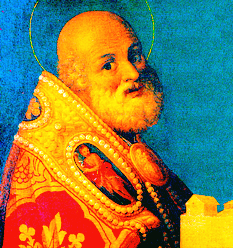(If you want to see parts one and two and three.)
If we follow Shakespeare's themes, King Henry V surprised his subjects when his coronation transformed him into an able and savvy ruler, as compared to the frivolous youth he had recently been.He had plenty of military experience, however, prior to his father's death. He had commanded the English forces in Wales during the revolt of Owain Glendower. By 1410, with Henry IV ailing, the 24-year-old young Henry had been running much of the government (albeit with the help of his uncles, Henry and Thomas Beaufort; Thomas was named Chancellor at this time).
Still, Henry might have been content to rule England when he was crowned on 9 April 1413, but for the situation in France. Charles VI—whose first bout with delirium happened at the age of 24 in 1392, when he attacked his own men during a military expedition—was becoming increasingly unstable. Placed under the regency of two uncles, the Dukes of Berry and Burgundy, he became a pawn between them and his own brother, the Duke of Orléans, who wanted control by being a regent. These opposing forces created the Armagnac-Burgundian Civil War that lasted from 1407 until 1435.
A France in military and political turmoil looked ripe for a resumption of hostilities; and France had given support to Owain Glendower. Meddling in England's affairs was reason enough.
Henry sailed for France on 12 August 1415. His first target was the principal seaport of Harfleur. The siege took weeks, and dysentery hit the English troops hard. Henry had to leave a part of his army in Harfleur while he marched toward Calais, but an approaching French army forced him inland, away from his ships and his target. Unfortunately, this move by the French forced the encounter at Agincourt, where the French soldiers were bogged down in the muddy fields, making them easy targets for the longbow men commanded by Henry. The victory of the English was sufficient to lead to the Treaty of Troyes, in which Charles "disinherited" his son: Henry V would become King of France upon Charles' death. Charles' daughter Catherine de Valois married Henry in 1420. They had a son, Henry.
The deaths of both Charles V and Henry V within two months of each other in 1422. Henry VI became king of both England and France; he was nine months old, and the only English king to have been officially named King of France. Skipping over decades of rocky reign, the English lost control of France decisively at the Battle of Castillon on 17 July 1453, which lost Gascony/Aquitaine, the English throne's major territory on the continent for the previous three centuries.
This has been (necessarily) a much-abbreviated look at the Hundred Years War, which ended in 1453. Next I want to explain why I think 1453 is a good year to say the Middle Ages were well and truly over.





























